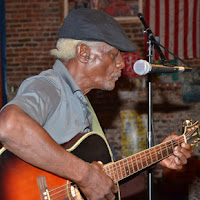"Mississippi" Fred McDowell's natch'l blues
But years before that unfortunate day, he had become a major figure of Mississippi country blues and a master of "bottleneck" guitar (he first used a pocketknife for a slide, later a polished beef rib bone, before finally settling on a self-shaped glass bottleneck around his ring finger). His music was basically rooted deeply in the Hill Country style, but he blended it with some traditional Delta blues forms.
His "Mississippi" nickname is peculiar since he was born just across the state line in Rossville, Tennessee, east of Memphis, and finally didn't settle down around Como before the end of the 1930s or beginning of the 1940s, after a bit of a hectic working life through cotton fields and plants, or in the hard times, hoboing and busking in the streets like many of his fellow bluesmen at that time.
This itinerant early life probably explains that he was exposed to and influenced by several styles of blues, and that he became a fine observer of social life around him. Playing for tips wherever he could in his teens and twenties, he managed to settle down and then performed at dance parties, picnics and other social gatherings from the 1930s to the 50s.
Until 1959 when ethno-musicologist Alan Lomax "discovered" him and made some "field recordings" of him, released on disc in 1960. McDowell suddenly came out from the shadows of his Como farm to the lights of the folk revival, especially after his performance at the 1964 Newport Folk Festival.
The present album has some similarities with Lomax's work three years earlier : it was taped at McDowell's home in 1962, in front of friends and neighbors, not in a studio. And what is unbelievable is the quality of the recording when you know it was done by two university students walking on Lomax's path without any commercial project. That idea came only in 1989, seventeen years after McDowell's passing, when one obscure UK. company specialized in reissue of old blues and R'n'B albums, Flyright Records, released it. But, chronologically, it's McDowell second recording.
A real jewel : McDowell is playing and singing so naturally. And so wonderfully. He sounds exactly as he was usually playing at festive gatherings in his Como area, apparently not at all disturbed by the presence of the tape recorder.
His blues was more percussive than the traditional Delta one, influenced by African and old European rhythms specific to the Hill Country blues roots, like the Fife & Drums music. McDowell's performances helped define the Hill Country blues guitar sound, influencing later artists such as the two R. L., Boyce and Burnside, or Junior Kimbrough.
< Fred McDowell Blues Trail marker in Como..
Through twenty magnificent pieces, this miraculous early home-recorded album already summarizes all of McDowell genius as an acoustic slide guitar blues performer. Featured are his extraordinary wild version of "Shake 'Em On Down"; the superbly slide played "On The Frisco Line"; "I Rolled And I Tumbled", his own version of the famous "Rollin' and Tumblin'"; the social revolt of "Red Cross Store Blues" and "John Henry"; and his great renditions of "Good Morning Little School Girl", "Milk Cow Blues", "Highway 61", "Someday Baby" or the iconic "Kokomo Blues", to name a few. McDowell performance, sometimes discreetly punctuated in the background by appreciations and laughter from the audience, takes the listener down in bygone rural Mississippi for a highly enjoyable and fascinating lesson of authentic country blues.
One year after this homage from a world famous white British rock band, at "only" 66, McDowell's time had come and he definitely had got to move. But thanks to an album like this, he hasn't moved too far...
Illustrated discography :
https://www.wirz.de/music/mcdowell.htm

> A 14mn documentary about McDowell (University of Mississippi), 1969 : https://youtu.be/gEmqzkkCQBY or https://youtu.be/TnMGpn6qA3Y
> Live in 1969 (the introductory incrusted lines are not quite true about McDowell being "highly typical of the Delta blues style") :
- Part I : https://youtu.be/ZMr_JcW1qAs
- Part II : https://youtu.be/myctFmIkc5A
> Performing "John Henry" around 1962: https://youtu.be/54GNI2K3-ec
> "Goin Down to the River", around 1964: https://youtu.be/9TyzAAwJnIw
> "Louise" (from the DVD "Legends of Bottleneck Blues Guitar") : https://youtu.be/JU_UJwN3WnE
> Fred McDowell (from 0.00 to 15:25) and Big Joe Williams : https://youtu.be/dYsFVNWpAQI
> "You Gotta Move" by The Rolling Stones : https://youtu.be/8Uhh3a48XPA






































